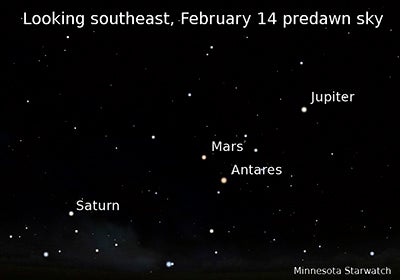Starwatch: A clear look at the winter constellations
Published 6:01 am Saturday, January 27, 2018
By Deane Morrison
University of Minnesota
With a new moon on the 15th, February’s darkest skies come in mid-month. Use the moonless evenings to enjoy the bright winter constellations, which dominate the southern sky after nightfall.
Grab a star chart and look low in the south for lovely Sirius, the brightest of stars. It radiates from Canis Major, the big dog, and can be imagined as a jewel in the dog’s collar. Sirius—also called the Dog Star—owes its status to its proximity; not quite nine light-years away, it’s one of our closest neighbors. Above Sirius and east of Orion is bright Procyon, in Canis Minor, the little dog. Procyon is another of our neighbors, only about 11.5 light-years away.
 In mid-evening look for Leo, rearing up in the east like a lion rampant. Its brightest star, Regulus, is at the base of a group of stars called the Sickle. The Sickle outlines the lion’s head; following it is a triangle of stars marking the hindquarters and tail. A spring constellation, Leo appears to be chasing the winter stars westward.
In mid-evening look for Leo, rearing up in the east like a lion rampant. Its brightest star, Regulus, is at the base of a group of stars called the Sickle. The Sickle outlines the lion’s head; following it is a triangle of stars marking the hindquarters and tail. A spring constellation, Leo appears to be chasing the winter stars westward.
In the morning sky, Saturn is low but climbing in the southeast. The ringed planet joins Scorpius, with Antares, its bright red heart; Mars, which glides over Antares in mid-month; and Jupiter, the beacon just northwest of Scorpius. Antares’ name means rival of Mars, so now is a great time to compare the red planet to its stellar competitor.
About four times every century, February gets no full moon, and 2018 is one of those years. Only February can lack a phase of the moon, because it’s the sole month shorter than the time it takes the moon to cycle between, say, one full moon and the next, which is 29.5 days. And when February lacks a full moon, January and March are almost certain to get two apiece, as they do this year.
But February always has Groundhog Day, an astronomically based holiday. It’s one of four “cross-quarter days” celebrated by the ancient Celts midway between a solstice and an equinox. It was believed that if the day was sunny it augured continued cold and winter, but cloudy, shadowless days presaged spring rains. The Celts called the day Imbolc, meaning lamb’s milk, because it fell at the start of lambing season.
The University of Minnesota offers public viewings of the night sky at its Duluth and Twin Cities campuses. For more information and viewing schedules, see:
Duluth, Marshall W. Alworth Planetarium: www.d.umn.edu/planet
Twin Cities, Minnesota Institute for Astrophysics (during fall and spring semesters): www.astro.umn.edu/outreach/pubnight.
Check out the astronomy programs at the University of Minnesota’s Bell Museum ExploraDome: www.bellmuseum.umn.edu/ForGroups/ExploraDome/index.htm.
Contact: Deane Morrison, University Relations, (612) 624-2346,morri029@umn.edu
Find U of M astronomers and links to the world of astronomy athttp://www.astro.umn.edu.




